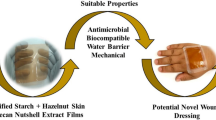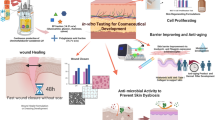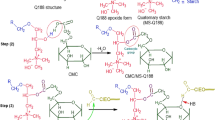Abstract
Cutaneous infections involve microbial invasion of pathogens into the skin layers and can lead to mild cases and severe life-threatening conditions. Biopolymeric films could be used to treat cutaneous infections and also meet the demand of the consumers for new biological-based products obtained from renewable sources. Sophorolipids are antimicrobial biosurfactants produced by the yeast Starmerella bombicola with great potential for application by pharmaceutical and cosmetic industries. The aim of this study was to produce and to characterize biodegradable films based on cassava starch, pullulan and sophorolipids for the control of skin pathogens, with and without the presence of citric acid as a crosslinking agent. Films were obtained by the casting method, and eight formulations were prepared using different concentrations of sophorolipids (0, 2.5, 5.0 and 10.0%-g/100 g polymer), with and without citric acid. The results showed that the addition of sophorolipids resulted in more opaque surfaces, forming homogeneous structures observed by scanning electron microscopy. Addition of citric acid resulted in films with higher flexibility, lower solubility and water vapor permeability values. The films containing sophorolipids in all concentrations were able to inhibit 100% of the growth of Staphylococcus aureus and Staphylococcus epidermidis. These findings lead to the possibility of developing new, sustainable, and natural antimicrobial sophorolipid films to treat bacterial skin infections.




Similar content being viewed by others
Data availability
All data generated or analyzed during this study are included in this published article.
References
Amakrishnan K, Salinas RC, Nelson IA, Higuita NIA (2015) Skin and soft tissue infections. Am Fam Physician 92:474–483
Ibrahim F, Khan T, Pujalte GG (2015) Bacterial skin infections. Prim Care 42:485–499
Cong TX, Hao D, Wen X, Li XH, He G, Jiang X (2019) From pathogenesis of ace vulgaris to anti-acne agents. Arch Dermatol 311:337–349
Alexander H, Paller A, Traidl-hoffmann C, Beck L, De Benedetto A, Dhar S, Girolomoni G, Irvine A, Spuls P, SU J, Thyssen J, Vestergaard C, Werfel T, Wollenberg A, Deleuran M, Flohr C (2020) The role of bacterial skin infections in atopic dermatitis: expert statement and review from the international eczema council skin infection group. Br J Dermatol Suppl 182:1331–1342
Voss GT, Gularte MS, De Oliveira RL, Luchese C, Fajardo AR, Wilhelm EA (2020) Biopolymeric films a delivery vehicles for controlled release of hydrocortisone: promising devices to treat chronic skin diseases. Mater Sci Eng C Mater Biol Appl 114:111074
Bouchelaghem S, Das S, Naorem RS, Czuni L, Papp G, Kocsis M (2022) Evaluation of total phenolic and flavonoid contents, antibacterial and antibiofilm activities of Hungarian Propolis ethanolic extract against Staphylococcus aureus. Molecules 27:574
Ismail AA, Farea MO, Awwad NS, Ibrahium HA, Eid MM, Menazefa AA (2022) Perspectives on composite films of chitosan-based natural products (Ginger, Curcumin, and Cinnamon) as biomaterials for wound dressing. Arab J Chem 15:103716
Pattanayaiying R, H-Kittikun A, Cutter CN (2015) Optimization of formulations for pullulan films containing lauric arginate and nisin Z. Food Sci Technol 63:1110–1120
Roy S, Kumari M, Haloi P, Chawla S, Konkimalla VB, Kumar A, Kashyap HK, Jaiswal A (2022) Quaternary ammonium substituted pullulan accelerates wound healing and disinfects Staphylococcus aureus infected wounds in mouse through an atypical ‘non-pore forming’ pathway of bacterial membrane disruption. Biomater Sci 10:581
Tang S, Zhang L, Mao X, Shao Y, Cao M, Zhang L, Liang X (2022) Pullulan-based nanocomposite films with enhanced hydrophobicity and antibacterial performances. Polym Bull. https://doi.org/10.1007/s00289-021-03996-0
Sueiro AC, Faria-Tischer PCS, Lonni AASG, Mali S (2016) Filmes biodegradáveis de amido de mandioca, pululana e celulose bacteriana. Quim Nova 39:1059–1064
Seligra PG, Jaramillo CM, Famà L, Goyanes S (2016) Biodegradable and non-retrogradable eco-films based on starch–glycerol with citric acid as crosslinking agent. Carbohydr Polym 138:66–74
Simões BM, Cagnin C, Yamashita F, Olivato JB, Garcia PS, De Oliveira SM, Grossmann MVE (2020) Citric acid as crosslinking agent in starch/xanthan gum hydrogels produced by extrusion and thermopressing. LWT 125:108950
Fontoura ICC, Saikawa GIA, Silveira VAI, Pan NC, Amador IR, Baldo C, Rocha SPD, Celligoi MAPC (2020) Antibacterial activity of sophorolipids from candida bombicola against human pathogens. Braz Arch Biol Technol 63:e20180568
Hipólito A, Silva RAA, Caretta TO, Silveira VAI, Amador IR, Penagio LA, Borsato D, Celligoi MAPC (2020) Evaluation of antifungal activity of sophorolipids from Starmerella bombicola against food spoilage fungi. Biocatal Agric Biotechnol 29:101797
Silveira VAI, Marim BM, Hipólito A, Gonçalves MC, Mali S, Kobayashi RMT, Celligoi MAPC (2020) Characterization and antimicrobial properties of bioactive packaging films based on polylactic acid-sophorolipid for the control of foodborne pathogens. Food Packag Shelf Life 26:100591
Caretta TO, Silveira VAI, Andrade G, Macedo F, Celligoi MAPC (2021) Antimicrobial activity of sophorolipids produced by Starmerella bombicola against phytopathogens from cherry tomato. J Sci Food Agric. https://doi.org/10.1002/jsfa.11462
Ceresa C, Fracchia L, Fedeli E, Porta C, Banat IM (2021) Recent advances in biomedical, therapeutic and pharmaceutical applications of microbial surfactants. Pharmaceutics 13:466
Silveira VAI, Nishio EK, Freitas CAUQ, Amador RI, Kobayashi RKT, Caretta T, Macedo F, Celligoi MAPC (2019) Production and antimicrobial activity of sophorolipid against Clostridium perfringens and Campylobacter jejuni and their additive interaction with lactic acid. Biocatal Agric Biotechnol 21:101287
ASTM (1996) Standard test methods for water vapor transmission of material, E96 95. In: Annual book of ASTM. American Society for Testing and Materials, Philadelphia, PA
ASTM (1996) Standard test methods for tensile properties of thin plastic sheeting, D882–91. In: Annual book of ASTM. American Society for Testing and Materials, Philadelphia, PA
CLSI (The Clinical and Laboratory Standards Institute) (2015) Methods for dilution antimicrobial susceptibility tests of bacteria that grow aerobically, Document M07, A10-tenth ed., CLSI, Wayne, PA, USA
Reddy N, Yang Y (2010) Citric acid cross-linking of starch films. Food Chem 118:3
Ashby RD, Zerkowski JA, Dky S, Liu LS (2011) Biopolymer scaffolds for use in delivering antimicrobial sophorolipids to the acne-causing bacterium Propionibacterium acnes. New Biotechnol 28:24–30
Ziemba AM, Lane KP, Balouch B, D’Amato A, Totsingan F, Gross RA (2019) Lactonic sophorolipid increases surface wettability of poly-L-lactic acid electrospun fibers. ACS Appl Bio Mater 2:3153–3158
Wu H, Lei Y, Lu J, Zhu R, Xiao DI, Jiao C, Xia R, Zhang Z, Shen G, Liu Y, Li S, Li M (2019) Effect of citric acid induced crosslinking on the structure and properties of potato starch/chitosan composite films. Food Hydrocoll 97:105208
Pereira JF, Lonni AASG, Mali S (2022) Development of biopolymeric films with addition of vitamin C and catuaba extract as natural antioxidants. Prep Biochem Biotechnol 52:1–10
Afonso CR, Hirano RS, Gaspar AL, Chagas EGL, Carvalho RA, Silva FV, Leonardi GR, Lopes OS, Silva CF, Yoshida CF (2019) Biodegradable antioxidant chitosan films useful as an anti-aging skin mask. Int J Biol Macromol 132:1262–1273
Queiroz VM, Kling ICS, Eltom AE, Archanjo BS, Prado M, Simão RA (2020) Corn starch films as a long-term drug delivery system for chlorhexidine gluconate. Mat Sci Eng C 112:110852
Hajji S, Ktari N, Ben Salah R, Boufi S, Debeaufort F, Nasri M (2022) Development of nanocomposite films based on chitosan and gelatin loaded with chitosan-tripolyphosphate nanoparticles: antioxidant potentials and applications in wound healing. J Polym Environ 30:833–854
Pan NC, Bersaneti GT, Mali S, Celligoi MAPC (2020) Films based on blends of polyvinyl alcohol and microbial hyaluronic acid. Braz Arch Biol Technol 63:e20190386
Miskeen S, Hong JS, Choi HD, Kim JY (2021) Fabrication of citric acid-modified starch nanoparticles to improve their thermal stability and hydrophobicity. Carbohyd Polym 253:117242
Hipólito A, Caretta TD, Silveira VAI, Bersaneti GT, Mali S, Celligoi MAPC (2021) Active biodegradable cassava starch films containing sophorolipids produced by Starmerella bombicola ATCC® 22214™. J Polym Environ 29:3199–3209
Solaiman DKY, Ashby RD, Zerkowski JA, Krishnama A, Vasanthan N (2015) Control-release of antimicrobial sophorolipid employing different biopolymer matrices. Biocatal Agric Biotechnol 4:342–348
Elshafie AE, Joshi SJ, Al-Wahaibi YM, Al-Bemani AS, Al-Bahry SN, Al-Maqbali D, Banat IM (2015) Sophorolipids production by Candida bombicola ATCC 22214 and its potential application in microbial enhanced oil recovery. Front Microbiol 6:1324
In YW, Kim JJ, Kim HJ, Oh SW (2013) Antimicrobial activities of acetic acid, citric acid and lactic acid against Shigella species. J Food Saf 33:79–85
Mahmoud BSM (2014) The efficacy of grape seed extract, citric acid and lactic acid on the inactivation of Vibrio parahaemolyticus in shucked oysters. Food Control 41:13–16
Freitas CAUQ, Silveira VAI, Cellligoi MAPC (2018) Antimicrobial applications of sophorolipid from Candida bombicola: a promising alternative to conventional drugs. Adv Biotech Micro 9:e555753
Dubey P, Raina P, Prabhune A, Kaul-Ghanekar R (2016) Cetyl alcohol and oleic acid sophorolipids exhibit anticancer activity. Int J Pharm Pharm Sci 8:399–402
Li H, Guo W, Ma X, Li J, Song X (2017) In vitro and in vivo anticancer activity of sophorolipids to human cervical cancer. Appl Biochem Biotechnol 181:1372–1387
Naz S, Banerjee T, Totsingan F, Woody K, Gross RA, Santra S (2021) Therapeutic efficacy of lactonic sophorolipids: nanoceria-assisted combination therapy of NSCLC using HDAC and Hsp90 inhibitors. Nanotheranostics 16:391–404
Funding
This work was supported by the National Council for Scientific and Technological Development (CNPq), Coordination for the Improvement of Higher Education Personnel (CAPES), RHAE/CNPq Program 2021 (350351/2022-8), and the Laboratory of Spectroscopy (ESPEC) and Laboratory of X-Ray analysis (LARX) of the State University of Londrina, CNPq/RHAE program (Grant number: 424022/2021-4).
Author information
Authors and Affiliations
Contributions
GAF contributed to conceptualization, formal analysis, investigation, methodology, visualization, writing—original draft preparation, writing—review and editing. VAIS contributed to methodology, writing—original draft preparation. MCG contributed to methodology, visualization. RRBM contributed to methodology. CVN contributed to methodology, resources. GTB contributed to methodology, visualization, writing—original draft preparation, writing—review and editing. CB contributed to conceptualization, methodology, resources, writing—review and editing SM contributed to conceptualization, methodology, resources, writing—review and editing. RKTK contributed to conceptualization, methodology, resources, writing—review and editing. MAPCC contributed to conceptualization, funding acquisition, methodology, project administration, resources, supervision, writing—review and editing.
Corresponding author
Ethics declarations
Conflict of interest
The authors declare that there are no conflicts of interest.
Additional information
Publisher's Note
Springer Nature remains neutral with regard to jurisdictional claims in published maps and institutional affiliations.
Rights and permissions
Springer Nature or its licensor (e.g. a society or other partner) holds exclusive rights to this article under a publishing agreement with the author(s) or other rightsholder(s); author self-archiving of the accepted manuscript version of this article is solely governed by the terms of such publishing agreement and applicable law.
About this article
Cite this article
Filipe, G.A., Silveira, V.A.I., Gonçalves, M.C. et al. Bioactive films for the control of skin pathogens with sophorolipids from Starmerella bombicola. Polym. Bull. 80, 10809–10823 (2023). https://doi.org/10.1007/s00289-022-04575-7
Received:
Revised:
Accepted:
Published:
Issue Date:
DOI: https://doi.org/10.1007/s00289-022-04575-7




